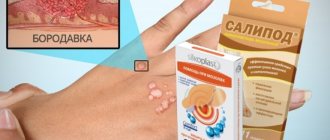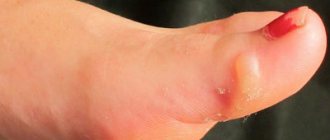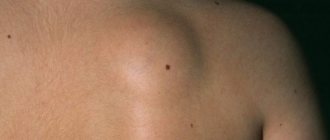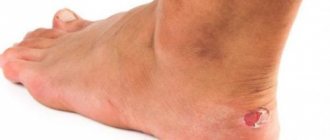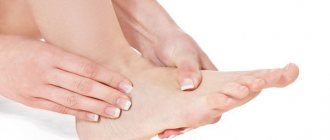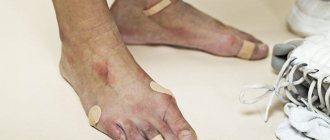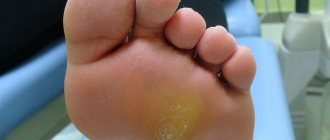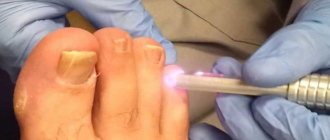When wearing uncomfortable shoes, synthetic socks and tights, a callus may form on the heel. People with excess body weight, flat feet or other defects associated with the musculoskeletal system are predisposed to problems associated with calluses. How to get rid of calluses on your heels in a short time? When calluses appear, they use traditional medications and recipes from traditional medicine.
Reasons for appearance
The main factor that can cause a heel callus to appear is hyperkeratosis or thickening of the keratinized tissue of the layers of the epidermis. The skin on the heels can become rough in all people, but older people most often face this problem.
Why calluses form in the heel area:
- Calluses arise from new shoes, a large blister forms while walking in stiletto heels, or wearing shoes of poor quality or the wrong size. If you wear synthetic socks.
- Inadequate foot skin care
- Excess body weight
- Lack of vitamins
- Fungal infections
- Eczema on heels
- Dermatitis
- Increased sweating of the feet
In addition, the cause of the appearance of a bubble is professional employment, which involves standing on your feet for a long time or carrying various heavy objects. The skin may also be prone to increased keratinization. This is a feature of the body, not a mechanical factor.
To quickly get rid of a growth on the heel, you need to learn to recognize what kind of callus it is before it appears completely. Initially, the skin turns red, the affected area swells and dries out. Pressing or rubbing the callus is painful. A bubble then forms and when it bursts, the skin is exposed.
When walking, it hurts to step on the heel area, making it difficult to put on shoes. Calluses on the heels can dry out and go away on their own, but it is better to take measures to treat them, because when the bubble bursts, inflammation may occur.
Types of calluses
To understand what to do if you have rubbed a callus, you need to find out what type it can be classified as.
Callous growths are divided into a number of largest classes:
- Dry calluses develop from keratinized epithelium. The main reason for such formations has not yet been clarified, but there is an assumption that the cause of development is a fungal infection or a dermatotropic virus.
- Callus with a core - brings severe pain. Such calluses appear due to neglect of dry growth on the heels. It happens that an internal callus forms around a driven splinter, which requires its quick removal.
- Callus - appears due to a bone fracture, or when a spur forms on the heel.
- Wet calluses are a constant companion of summer shoes. It is formed due to excessive rubbing of the heel on the shoe. When squeezed, it can burst, opening the wound.
- Blood calluses are a consequence of bursting dropsy. This type requires careful handling, as suppuration may occur in the heel area.
Mild dry and wet calluses on the heels can be treated at home. However, when a lesion on the foot does not heal, you need to go to a specialist so that a complication does not appear.
Dry callus
Externally, dry type calluses are a compaction on the heels, presenting a round or oval shape. Corns appear due to the hardening of the sole due to endless friction.
Dry callus (corns)
The formation of education is quite long.
Initially, a small compaction is formed, which after a certain period of time can increase.
A dry callus on the heel practically does not lead to pain and does not cause a feeling of discomfort. After a while, the compacted area on the heels becomes hard and can ache when moving. A person may experience a change in gait and lameness.
The presence of dry and hard calluses on the heels may indicate health problems.
Wet callus
Wet Callus
A water callus forms on the heels due to simple mechanical friction of the foot, often against shoes. Due to the friction process, the upper skin layer is damaged, and the resulting void is filled with colorless contents.
A wet callus forms on the heel, often due to wearing shoes with a fairly hard back, as well as due to walking in new shoes that have not yet been worn in to fit the model of the limb. Dropsy on the toe occurs when the toe in the shoes is too tight or the shoes are too large.
A wet callus can occur as a result of an untreated growth of the previous type. When you press on the dropsy, it bursts and a wound opens. Infection may occur, which is manifested by redness, suppuration and increased soreness in the heel area. With this callus, you need to urgently contact a specialist.
If you have a callus with dropsy on your heel, special care is required to avoid infection.
Calluses in children
Due to the inability of parents to choose the right shoes for their child, this often leads to the formation of calluses. A contributing factor is the soft and delicate skin of the heels, as well as everyday pressure on the feet.
Common calluses in children are growths and water calluses, often appearing on the heels, bottom of the big toe and in the upper area.
To prevent the occurrence of calluses, you should buy your child leather products and cotton socks, which should be washed daily.
Dry calluses in children are removed with compresses and baths prescribed by the doctor. They will help soften calluses, which will allow them to be gradually eliminated using pumice. Since it is difficult to apply compresses to a child during the day, it is recommended to treat the affected area with a nourishing baby ointment during the day to prevent the development of cracks in the heel area.
Water calluses on the heels can be covered with a plaster or you can go to a doctor, who will open the dropsy and treat it with an antibacterial medication, apply cream and fix a bandage on the heel.
Preventive measures
To prevent the initial occurrence of calluses or their recurrence, it is recommended:
- Choose your shoes carefully. It should be soft and well ventilated. There should be no seams protruding inside that would rub the heel. You should give preference only to high-quality shoes.
- Wear socks or tights only from natural high-quality fabrics.
- If you have problems with the frequent appearance of wet calluses or are planning a long walk, it is better to always have a disinfectant on hand.
- Be sure to isolate the callus with a bandage at the first sign of its appearance.
- Don't forget about the rules of personal hygiene. To prevent dry or wet patches from developing, you should wash your feet daily with warm, soapy water. Additionally, you can use decoctions or infusions of string or calendula. Several times a week, it is good to steam your heels and remove dead skin from them, if any, and use foot balms.
- Pay attention to vitamin and balanced nutrition.
Treatment of calluses
How to quickly cure a callus? Treatment of calluses on the heels is carried out taking into account the type of growth.
To heal calluses faster, a variety of methods are used, from home recipes to pharmaceutical preparations. If the callus cannot be eliminated on your own at home, you need to go to the doctor.
Treatment of dry calluses
How to treat a callus on the heel when it is dry? It is easy to fix the problem, but it will take a lot of time to achieve it. If you follow all the instructions, very soon you will be able to forget that there was a callus on your heel.
- Initially, with dry formations, heels are treated by removing the hardened layer of the epidermis, which does not allow them to heal quickly. You should steam your feet in warm water, adding soda or soap solution. After manipulation, keratinized skin is easily removed using pumice and a scraper.
- To speed up healing, it is recommended to take baths every day, adding tinctures of medicinal plants. The procedure lasts about 15 minutes.
To get rid of dry growths on the heels, you can use pharmaceutical medications - Salicylic ointment.
Treatment of wet calluses
The unique feature of a water callus is that it can heal on its own. Lymph, which is located in the bladder, protects tissues and prevents the occurrence of trauma. After time, the liquid resolves on its own, which requires subsequent provision of the necessary conditions for healing.
Water Bubble
To do this, do not put pressure on the affected area and create comfort for your heels. The healing period for water calluses is 14 days.
Compared to other types of formations, wet callus is much easier to treat. It is important to immediately begin to fight it, because if time is lost, dropsy will turn into dry dropsy.
There is an assumption that an easy method of treating water callus is to puncture it. However, it is forbidden to open them, because there is a risk of introducing microbes into the wound. If infection occurs, the delay will be long and painful.
Before eliminating the water bubble, you should wash your feet with cold water to relieve the pain syndrome. If you steam your feet in hot water, this will provoke the spontaneous opening of dropsy and cause unbearable pain.
After washing, the feet should be dried and treated with salicylic acid, and then cover the area with an anti-callus patch. It is recommended to make compresses using lemon zest or yarrow leaves. This compress is applied for 2 hours and secured with a bandage. To speed up the opening of the bladder, you can buy special medications at the pharmacy.
There are cases when all the tried methods did not bring the desired result. Then this is the case that in this situation allows you to open the dropsy yourself. To carry out the procedure, you need to take a thin needle and treat it in an alcohol solution. Wash your hands and feet.
The water bubble is pierced from the side. When all the contents of the bladder are released, the wound is treated with peroxide. Next you need to apply an antiseptic cream and stick on a bandage.
If the dropsy bursts on its own, treatment is carried out as follows:
- A burst callus is treated with peroxide or washed with soap;
- The wound is lubricated with ointment, a folk medicine, for rapid healing of the formation.
Treatment of callus in a child
Callus on the heel can be treated without problems at the onset stage. Therapy may include the use of medications, as well as traditional methods. Before using the products, you should consult your doctor, since the child’s body may react negatively to certain products.
Core callus
Traditional treatment methods for children are recommended:
- Hot baths with soapy water – the procedure lasts half an hour, the bath temperature should be quite high. Then the heels are treated with pumice;
- Salicylic ointment - 5% is suitable for children's skin. Use the product once a day before going to bed. Over time, the callus will begin to dissolve. If this is not observed, it is recommended to interrupt treatment for a couple of days, then try using the ointment after a hot bath;
- Celandine gets rid of the problem due to its drying effect; the plant also disinfects and kills all microbes on the child’s affected skin. To prepare the lotion, you need to pass the fresh plant through a meat grinder and apply it to the calluses. Secure it on top with a bandage and put on a sock.
You can use the Salipod patch. It will quickly and painlessly eliminate calluses on the heels. The patch is attached to a clean, dry skin and secured on top with an adhesive tape. Wearing time is 3 days, then you need to steam the heels and extract the contents. This remedy is harmless for children.
Laser removal
Core formation requires special treatment and increased attention. It happens that traditional methods cannot get rid of the nail, so the heel area continues to hurt very much. Then how to remove callus on heels? Doctors offer hardware therapy, thanks to which it is possible to quickly get rid of calluses.
Laser removal is a painless and safe procedure; in addition, this method guarantees absolute protection against bacteria. The procedure lasts 10 minutes.
Removal process:
- Local anesthesia is administered using a syringe.
- Treat the growth with an antiseptic solution.
- Remove the rod.
- The medicine is dripped into the formed depression.
- Apply a soft bandage to the wound.
- The wound heals within 20 days.
There are also other hardware methods for removing calluses that a doctor can recommend - drilling and cauterization with nitrogen.
Treatment with folk remedies
Anyone who has had a growth has wondered how to cure a callus quickly at home? What to do if calluses in the heel area fester? It is possible to recover from festering calluses using folk remedies.
Bursted Callus (Fig-1)
A doctor will also help you get rid of purulent accumulations. As a rule, the fight against suppuration takes place in the surgical department. Often, when the callus festers, it is opened and washed with a disinfectant.
Bursted Callus (Fig-2)
There are times when it is impossible to defeat a callus if it has festered without antibacterial drugs, which are prescribed exclusively by a specialist.
The most common methods for combating heel growths include:
- Using baths - they should be done every day until complete recovery. To prepare a medicinal bath, various herbal decoctions are used. Also, to steam the skin of the heels, make a solution of soda. The manipulation should take place over half an hour. Next, the softened foot should be treated with a brush, and then cream should be applied. Often, to completely get rid of a callus, 2-3 manipulations are required.
- Compress - from a cut yarrow leaf. The lotion is applied all night. In the morning, everything is washed off with warm water, and the feet are wiped dry.
- Calluses are healed with onions, which are pre-moistened in vinegar.
- An effective remedy is vinegar essence. You just need to apply 2-3 drops of the product to the formation and after a while you will see positive results. It is recommended to fix the damaged area with a bandage.
- You can make an ointment at home. Garlic is baked and combined with butter in equal parts.
- An excellent folk remedy is a mass of potatoes, which should be fixed on the heels as a lotion throughout the night.
- Aspirin tablets help. You need to make a powder from 2 pills, apply it to the growth, leave for an hour.
- Heel calluses are removed using lard and garlic. The garlic is ground and applied to a piece of lard. The compress is applied to the heel with garlic gruel until the morning, with the leg bandaged.
- You can quickly get rid of internal calluses by applying a paste of calendula leaves mixed with hot water to your heels.
- To combat the growth at home, take a lemon peel and tie it to the foot until the morning. Before the manipulation, the heels are steamed.
- You can apply garlic or lemon oil using a cotton swab. After 7 days the growth will go away.
- An interesting folk remedy is a ripe tomato, which should be applied to the heel in the morning. Thanks to the acid present in the tomato, it will destroy the callus.
If after a series of manipulations it was not possible to get rid of the problem, then you need to show the callus to a doctor. After examination, the specialist will help eliminate the formation, prescribing the best option for eliminating the growth.
Pharmacy products
Pharmaceutical production produces large volumes of ointments and creams for calluses on the heels. They help soften the skin of the feet, heal blisters that have burst, and numb the painful area.
How to treat a callus? A number of tools will help you cope with this problem:
- Pro Linc Be Natural Callus Eliminator - calluses after smearing with the gel become much more pliable, which makes it easier to eliminate. This callus treatment helps in removing small calluses while facilitating healing of the skin.
- Oriflame Feet Up Advanced - cream has a softening effect. It helps with dry formations and prevents the appearance of a rod.
- Avon Foot Works - a product used for baths that resembles a liquid gel. For the steaming procedure, a measured amount of the drug is added to a bowl of hot water. After manipulation, rough areas of skin can be easily removed using a file or pumice stone.
- Bensalitin ointment - helps in eliminating the inflamed bladder. The cream should be applied to the formation, and a bactericidal patch should be used on top. Remove the patch after 3 hours.
- Floresan Organic Foot Care is a cream that helps remove cracked heels. The medicine contains celandine and pine nut oil, they help soften the skin and heal wounds.
What should I apply to make the callus heal? For healing, lubricate the heels with Super Antimozolin ointment. The ointment contains lactic acid. You need to lubricate the sore heel well with the drug, cover it with paper and put on a sock. Over time, the dead skin will fall off and can be removed with a brush.
Emollient ointments and creams will help prevent corns, but if the callous growth is large, creams are often useless. For this situation, strong pharmaceutical agents are used.
- Super celandine is a liquid that is used to burn off rough skin. You should use the medicine carefully so that it does not get beyond the dry callus. Therapy is carried out 2 times a day, 2 drops are applied to the required area.
- Stopcallus is a semblance of Supercleaner. The treatment procedure is the same.
To get rid of serious ingrown, core formations, corns, use a callus patch:
- Salipod is a special plaster in the fight against rod growths. An excellent helper in protecting the skin from bacteria.
- Compide - used for wet calluses. The patch prevents pressure and friction on the affected area.
- Urgo - a plaster is used to treat corns, dry calluses without a callus and with one. A special feature of the product is that it contains a special foam pad, which allows you to protect healthy tissues from the active influence of the drug.
- Leuko is a thin strip on which a medicine is placed on the inside of a plastic membrane. The patch allows air to pass through well, and the area with the medicine is reliably limited from healthy epithelium.
Patches that contain medicinal components are drugs, so you should consult a doctor before using them.
Traditional medicine recipes
There are a huge number of folk recipes to remove calluses. Here are several recipes that are the most popular and effective.
- You will need to take equal parts of an onion, an aloe leaf and a raw potato. The ingredients must be crushed to obtain a homogeneous paste. Then the mixture is applied to the affected area and fixed with a plaster. After a day, you can scrape off the softened skin. Next, apply ointment for the heels.
- You can easily fix the problem by using celandine juice or ointment with lard 1:1.
- Lubricate the heel with dandelion juice. This recipe is effective in the presence of dry calluses.
- The top of the lemon with the pulp is applied to the heel until the morning and secured with a bandage. Before use, you need to steam your feet.
- Potassium permanganate is diluted to a dark brown hue. The heels are lowered into the solution for 15 minutes, then the formations need to be lubricated with iodine. Treatment is carried out 3 times for 7 days. After several manipulations, the calluses will go away completely.
- If the callus is old, it is recommended to apply a lotion made from bread crumb, which is soaked in vinegar, to the heel.
- The water bubble will go away unnoticed if you apply a lotion of fish oil and aloe juice, combining the ingredients in equal parts. Then a cotton pad is moistened in the resulting mass, applied to the damaged area and sealed with a band-aid.
- You need to boil prunes in fresh milk, and then apply them warm to the heel, securing them with a bandage.
These recipes will help heal the callus if you follow all the recommendations.
Baths
If calluses are about to begin to appear on your heels, their growth can be prevented by using special baths.
- You need to add tea tree oil, baking soda, salt or apple cider vinegar to the water. Thanks to these components, the skin will soften and excess keratinized heels will be removed.
- If a dry callus forms, a soap bath will help. It is necessary to grind the laundry soap to make a tablespoon, then dilute it in water and pour the finished product into a basin. This manipulation is considered the most effective in the fight against calluses. This procedure can both get rid of the rough layer of skin and make the heels soft and tender.
- To prepare the product, you will need to pour boiling water over 8 handfuls of leaves. Cool the product and add it to a bowl of hot water. Steam your heels for about 30 minutes. To enhance the healing process, you need to lubricate your heels with a nourishing ointment.
- The recipe includes 3 tablespoons of the product, which must be diluted in a liter of boiling water. Then the mixture is poured into a basin and hot water is added. Feet should be kept in the solution for about 20 minutes. Then wipe well and apply the cream to the calluses. It is recommended to wear socks at night.
- You will need to pour boiling water over the straw and put it on fire. Bring to a boil, reduce heat and simmer for 30 minutes. Then remove the straw from the pan, cool the liquid, pour into a basin, dilute with water and you can steam your heels.
- The procedure will require several crystals of potassium permanganate, a pinch of salt and water. You should not take too much manganese, as it may cause burns. Add salt to the diluted manganese and mix well. Then treatment is carried out.
Propolis
Propolis is widely used to cure calluses on the heels. This product is effective both in its natural form and in combination with other ingredients.
Propolis
Recipes with propolis:
- Pure propolis is applied to the steamed area for 3 days and fixed with a bandage.
- Purified propolis - 60 grams is mixed with heated Vaseline - 50 grams to obtain a homogeneous mass. Then you need to squeeze the mixture through cheesecloth and transfer it to a jar. The finished ointment is applied in a small layer to the sore heel, and a bandage is applied on top.
- You will need beeswax - 30 grams, propolis - 50 grams and lemon juice, combine together in an enamel vessel, heat the mixture in a water bath until smooth. The mixture is applied to the calluses and fixed for 4 days.
Celandine
You can treat calluses with celandine juice. To do this, you need to cut the plant to release the orange juice. The juice should be applied to the steamed callus every day for about 2 weeks.
Celandine juice
Infusions and decoctions from the plant are also prepared. Dry herb - 50 grams, pour 250 ml of boiling water and keep in a water bath for about 20 minutes. When the broth has cooled, it is filtered. The solution is poured into the bath and calluses on the heels are treated.
To prepare homemade ointment from celandine, you will need to mix the juice of the plant with fat or take Vaseline 1:4. The product is applied overnight and secured with a bandage. Treatment lasts about 10 days.
Which doctor should I contact for help?
- The main specialist is a dermatologist. However, depending on the nature of the disease, there may be other options.
- In the case of callus, you should seek help from a surgeon. It will also help with purulent, infected and severe calluses.
- In other situations, aesthetic medicine specialists can come to the rescue. Using cryotherapy, laser or hardware drilling, the defect can be removed.
In particularly advanced situations, the intervention of a surgeon and an operation may be required, which will affect the entire life activity of a person and limit the usual physical activity. In addition to laser and surgery, conventional ointments can be used in treatment. But often a person notices the presence of a problem already in an advanced state, which requires a serious approach to recovery.
To effectively combat calluses, their prevention is necessary. In areas most susceptible to mechanical stress, it is worth applying cream in the evenings or gluing a patch when wearing uncomfortable shoes. Socks and shoes on your feet must match in size and be made from natural fabrics and materials.
source
How to prevent calluses
To prevent the formation of calluses on the heel, you must adhere to a number of rules:
- Choose shoes that fit, are comfortable, and made from natural materials.
- Use natural socks that should not form wrinkles and fit snugly to the foot.
- Feet require proper attention in summer. You can use talc to prevent your feet from slipping and rubbing on your shoes.
- If calluses appear on the damaged area due to shoe friction, you should stick a patch on the heel.
- To prevent flat feet, use special insoles.
Note!
You cannot cut the callus with scissors or a razor. She needs to be treated!
If, after using steam baths, you plan to apply ointments or pastes from folk remedies to the callus, you should not clean your heel with a pumice stone.
You need to get rid of calluses as soon as you find them. The larger the callus, the more difficult it is to cure it later. It is also possible to experience pain and discomfort when walking.
Until the callus is cured, avoid uncomfortable, hard shoes, use a patch before going out, and try to reduce the load on the damaged heel.
You can also remove dry calluses in a beauty salon using a pedicure machine.
